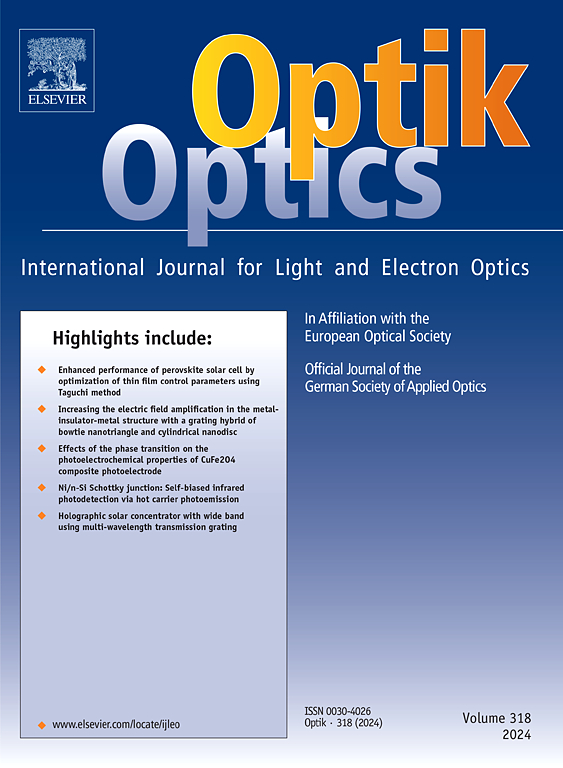高对比度光栅嵌入式多总线微光三环谐振温度传感器的设计与仿真
IF 3.1
3区 物理与天体物理
Q2 Engineering
引用次数: 0
摘要
本文介绍了一种在z域设计和模拟高对比度光栅嵌入式微光学三环谐振温度传感器的新尝试。该传感器配置有三个环形半径不同的波导环,并与两个线性波导建立环形共振。唯一集成的传感器元件是Bragg光栅,它在相邻单元之间提供高指数对比度,并在z域中建模为单个单元传递函数。传递函数公式考虑级联结构方向和光栅的均匀单元宽度,并包括相位项来解决折射率差异。得到了复合三环谐振Bragg光栅传感器的信号流图表示,并利用Mason增益公式确定了传输传递函数。所述方法完全依赖于从z−1到z−(1+∆M)的单位延迟扰动和延迟线信号处理技术的执行,并说明了传感器对0-500℃温度变化的光谱响应。仿真工作和频响可视化首选MATLAB平台。最后,测量光学属性,如自由光谱范围,峰值透射率和光谱移位幅度,以检查传感器响应曲线。本文章由计算机程序翻译,如有差异,请以英文原文为准。
High contrast grating embedded multi-bus micro-optical triple ring-resonated temperature sensor design and simulation
The article introduces a novel attempt to design and simulate a high-contrast grating embedded micro-optical triple ring-resonance temperature sensor in the Z-domain. The sensor is configured with three waveguide rings, having different ring radii, and establishes ring resonance with the two linear waveguides. The only sensor element incorporated is the Bragg grating, which offers a high-index contrast between the adjacent cells and is modelled as an individual cell transfer function in the Z-domain. The transfer function formulation considers a cascade structure orientation and a uniform cell width of the grating and includes a phase term to address the refractive index differences. The signal flow graph representation of the composite triple ring-resonated Bragg grating sensor is also obtained, and, using Mason’s gain formula, the transmission transfer function is determined. The stated methodology exclusively relies on the unity-delay perturbation from to and the execution of the delay line signal processing technique, and illustrating the sensor’s spectral response for 0–500 C temperature variation. The MATLAB platform is preferred for the simulation work and frequency response visualization. Finally, optical attributes like free spectral range, peak transmission, and spectrum shift magnitude are measured to examine the sensor response profiles.
求助全文
通过发布文献求助,成功后即可免费获取论文全文。
去求助
来源期刊

Optik
物理-光学
CiteScore
6.90
自引率
12.90%
发文量
1471
审稿时长
46 days
期刊介绍:
Optik publishes articles on all subjects related to light and electron optics and offers a survey on the state of research and technical development within the following fields:
Optics:
-Optics design, geometrical and beam optics, wave optics-
Optical and micro-optical components, diffractive optics, devices and systems-
Photoelectric and optoelectronic devices-
Optical properties of materials, nonlinear optics, wave propagation and transmission in homogeneous and inhomogeneous materials-
Information optics, image formation and processing, holographic techniques, microscopes and spectrometer techniques, and image analysis-
Optical testing and measuring techniques-
Optical communication and computing-
Physiological optics-
As well as other related topics.
 求助内容:
求助内容: 应助结果提醒方式:
应助结果提醒方式:


